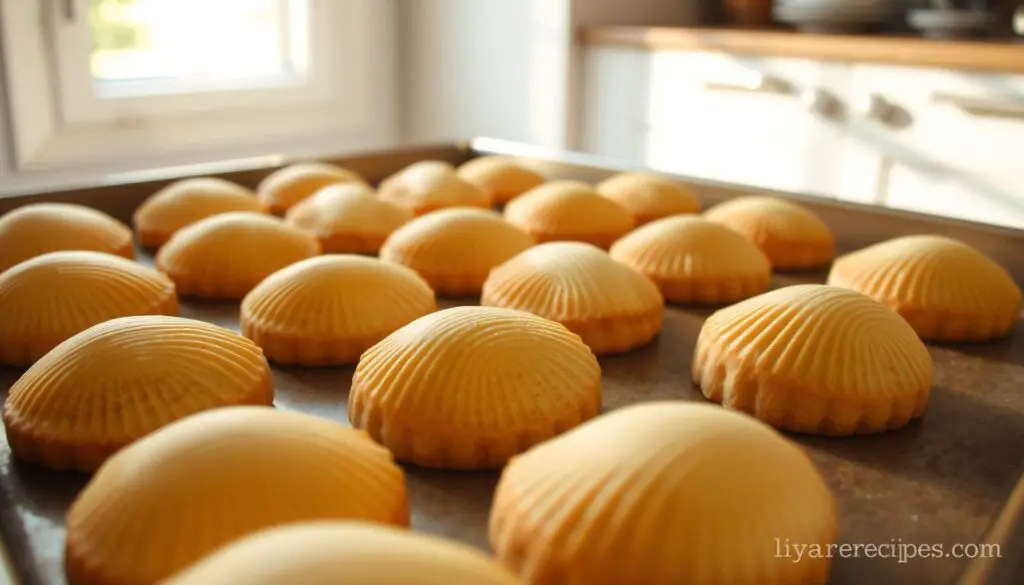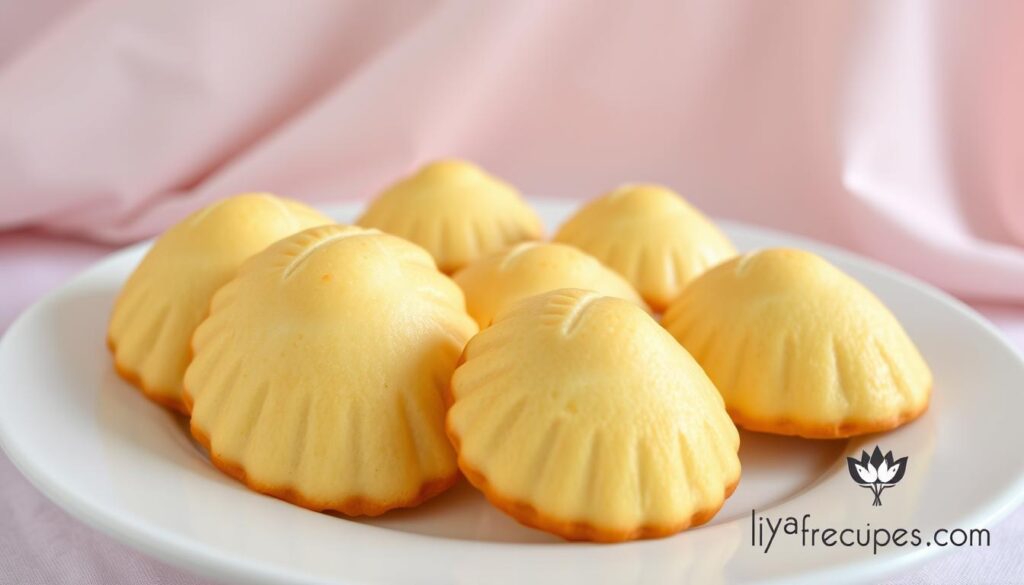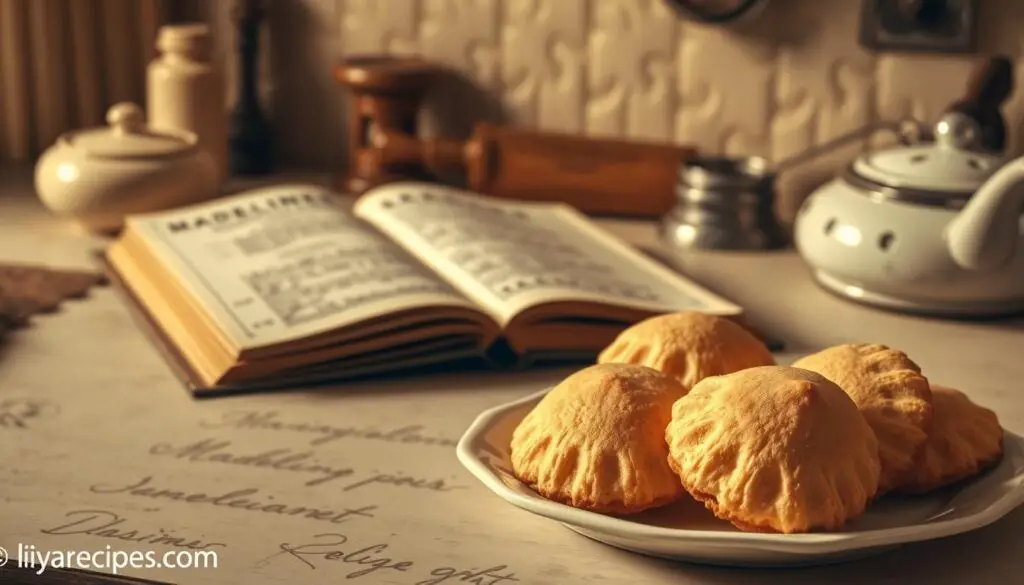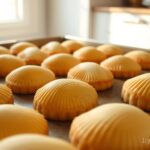There’s something magical about baking. The aroma of sugar and flour mingling in the air, the anticipation of a warm treat fresh from the oven—it’s a moment of pure joy. Among the many delights in the world of baking, madeleine cookies stand out as a timeless classic. Their delicate shell-like shape and tender texture make them a favorite for any occasion.

Originating from France, these little treats are more than just a cookie—they’re a piece of culinary history. This recipe brings a modern twist by incorporating cream, adding a rich moistness and depth of flavor. Whether you’re a seasoned baker or just starting, this guide will walk you through every step, ensuring perfect results every time.
From mixing the batter to achieving that golden-brown finish, this article covers it all. You’ll also find expert tips on storage and troubleshooting, making it easy to enjoy these delightful treats anytime. So, roll up your sleeves and let’s bake something extraordinary!
Key Takeaways
- Madeleine cookies are a classic French treat with a unique shell-like shape.
- This recipe uses cream for added moistness and flavor.
- Simple and accessible, perfect for both novice and experienced bakers.
- Includes expert tips on mixing, resting, and baking for perfect results.
- Provides troubleshooting and storage advice for long-lasting freshness.
Introduction to Madeleine Cookies
Few desserts capture the elegance of French baking like madeleines. These petite, shell-shaped sponge cakes are known for their delicate texture and rich, buttery flavor. Originating in France, they have been a beloved treat since the 18th century, often paired with tea or enjoyed as a light dessert.

What Are Madeleine Cookies?
Madeleines are more than just a sweet treat—they’re a piece of culinary history. Traditionally made with flour, sugar, eggs, and butter, they are baked in special pans that give them their iconic shell shape. Their light, airy texture and subtle sweetness make them a favorite among bakers and food lovers alike.
Why This Recipe Stands Out
This version of the classic recipe introduces a modern twist by incorporating cream into the batter. The addition of cream enhances the moistness and adds a depth of flavor that sets it apart from traditional butter-based recipes. Whether you’re a seasoned baker or a beginner, this approach ensures a delightful result every time.
From the careful mixing of ingredients to the precise baking process, this guide will walk you through every step. You’ll also find tips on achieving the perfect golden-brown finish and storing your madeleines for long-lasting freshness. Let’s dive into the world of baking and create something truly special!
History and Origins of Madeleine Cookies
The story of madeleines is a journey through French culinary history. These delicate treats first appeared in the 18th century, rooted in the Lorraine region of France. Their iconic shell shape and tender texture quickly made them a favorite among French nobility.

Madeleines gained royal recognition when they were served to King Louis XV. Their popularity soared, and they became a symbol of French baking finesse. Over time, they evolved from a regional specialty to a globally cherished dessert.
French Heritage and Cultural Influence
French heritage plays a significant role in the creation of madeleines. Traditional ingredients like eggs and vanilla are essential to their flavor profile. These elements, combined with precise baking techniques, result in a treat that embodies French culinary artistry.
The connection to French royalty adds a layer of cultural richness. Madeleines were often enjoyed during le goûter, a late-afternoon snack time. This tradition highlights their role in French daily life and their enduring appeal.
Today, madeleines are a testament to the evolution of baking. From their humble beginnings to their modern variations, they continue to captivate bakers and food lovers worldwide. Whether enjoyed plain or dipped in chocolate, they remain a timeless classic.
Key Ingredients and the Role of Cream
The foundation of any great baked treat lies in its ingredients. Each component plays a vital role in achieving the perfect texture, flavor, and appearance. For this recipe, the addition of cream elevates the classic formula, creating a moist and tender result.
Traditional Ingredients and Flavor Enhancements
Traditional recipes rely on a simple yet effective combination of ingredients. Flour provides structure, while sugar adds sweetness and helps create a crisp exterior. Eggs are essential for a light, airy texture, and butter brings richness and depth.
This recipe introduces cream, which enhances the moistness and adds a luxurious finish. Flavor enhancers like lemon zest and vanilla extract provide subtle yet impactful notes. A precise balance of these elements ensures a delightful treat every time.
Cream vs. Butter – A Delicious Debate
Butter has long been a staple in baking, offering a rich, buttery flavor. However, cream introduces a new dimension. It adds moisture and creates a softer texture, making each bite more indulgent.
Here’s a quick comparison of their roles:
| Ingredient | Role | Impact |
|---|---|---|
| Butter | Adds richness and flavor | Creates a crisp exterior |
| Cream | Enhances moistness | Results in a tender texture |
When combining these ingredients, it’s crucial to measure accurately. Use a teaspoon for smaller quantities and ensure the mixture is well-blended. Chilling the batter for the recommended time helps achieve the signature hump.
For storage, place the finished product in an airtight container to maintain freshness. Whether enjoyed immediately or saved for later, these treats are sure to impress.
Essential Equipment and Tools for Success
The right tools can make or break your baking experience. To achieve the iconic shape and texture of madeleines, having the proper equipment is crucial. From the pan to the mixing tools, each piece plays a vital role in ensuring success.
Choosing the Perfect Madeleine Pan
The madeleine pan is the star of the show. Its unique shell-shaped mold creates the signature appearance that defines these treats. Opt for a high-quality, non-stick pan to ensure easy release and even baking. Non-stick surfaces also make cleaning a breeze.
For beginners, alternatives like mini muffin tins or silicone molds can work. However, these won’t produce the same classic shape. If you’re serious about baking madeleines, investing in a dedicated pan is worth it.
Other Essential Tools
Beyond the pan, a few key tools are necessary. A sturdy mixing bowl ensures your ingredients blend smoothly. A whisk helps incorporate air into the batter, while a spatula ensures every bit of batter makes it into the pan. A sifter is also useful for achieving a smooth, lump-free mixture.
Preheating the oven is critical for even baking. Use an oven thermometer to ensure accuracy. The right-sized container for chilling the batter is equally important, as it helps develop the signature hump.
Maintenance Tips
To keep your tools in top condition, clean them thoroughly after each use. Avoid using abrasive materials on non-stick surfaces. Store your madeleine pan in a dry place to prevent rust. Proper care ensures your tools last for years and deliver consistent results.
With the right equipment and a little practice, you’ll be well on your way to baking perfect madeleines every time. Happy baking!
Preparing the Batter for Perfect Madeleines
Crafting the perfect batter is the cornerstone of achieving flawless madeleines. Every step, from mixing to resting, plays a crucial role in creating the iconic texture and shape. Let’s dive into the process to ensure your batter is just right.
Mixing Techniques for Light and Airy Texture
Start by combining wet ingredients like eggs, sugar, and cream. Beat them until the mixture becomes light and frothy. This step incorporates air, which is essential for an airy texture. Use a whisk or mixer on medium speed for about 3-4 minutes.
Next, sift the dry ingredients, including all-purpose flour and baking powder, to avoid lumps. Gently fold these into the wet mixture using a spatula. Overmixing can lead to dense results, so stop as soon as the ingredients are combined.
Resting and Chilling for the Ideal Hump
Once the batter is ready, cover it and let it rest in the refrigerator. Chilling for at least 1 hour, or preferably overnight, allows the flavors to develop and ensures the batter firms up. This step is critical for achieving the signature hump during baking.
Before baking, preheat your oven and prepare the madeleine pan. Lightly grease the pan to prevent sticking. Fill each shell-shaped cavity about three-quarters full with the chilled batter. This ensures even baking and the perfect rise.
By following these steps, you’ll create a batter that bakes into tender, golden madeleines every time. Happy baking!
Baking Process: Achieving the Iconic Madeleine Hump
The secret to perfect madeleines lies in mastering the baking process. From preheating the oven to monitoring the bake, every step contributes to the signature hump and golden texture. Let’s explore the techniques that ensure success.
Oven Preheating and Baking Tips
Preheating the oven is crucial. Set it to 375°F (190°C) for even heat distribution. This temperature allows the batter to rise quickly, forming the iconic hump. Use an oven thermometer to ensure accuracy.
Fill each mold about three-quarters full with chilled batter. Overfilling can lead to uneven shapes. Bake for 10-12 minutes, or until the edges turn golden and the centers spring back when lightly pressed.
Here’s a quick guide to baking madeleines:
| Step | Details |
|---|---|
| Preheat | 375°F (190°C) |
| Fill Molds | Three-quarters full |
| Bake Time | 10-12 minutes |
Troubleshooting Common Issues
If your madeleines turn out flat, the batter may not have been chilled long enough. Rest it for at least 1 hour, or overnight, for optimal results. Overbaking can dry them out, so monitor closely.
For uneven shapes, ensure the molds are evenly filled and the oven temperature is consistent. A light dusting of powdered sugar not only enhances the visual appeal but also adds a subtle sweetness.
Pro tip: Adding a touch of lemon zest to the batter can elevate the flavor profile. Experiment with small adjustments to find what works best for you.
By following these tips, you’ll achieve madeleines with the perfect texture and shape every time. Happy baking!
Serving, Storage, and Creative Presentation Ideas
Presentation and preservation are key to enjoying madeleines at their best. Whether you’re serving them fresh from the oven or storing them for later, these tips ensure they remain delicious and visually appealing.
Optimal Storage Methods for Freshness
To maintain the delicate texture of madeleines, proper storage is essential. At room temperature, place them in an airtight container for up to 3 days. This prevents them from drying out and keeps their cake-like softness intact.
For longer storage, freezing is a great option. Wrap each shell-shaped treat individually in plastic wrap, then place them in a freezer-safe bag. They can be stored for up to 2 months. Thaw at room temperature before serving to retain their freshness.
Garnishing and Serving Suggestions
Madeleines are versatile and can be dressed up for any occasion. A light dusting of powdered sugar adds an elegant touch. For a richer flavor, drizzle them with a chocolate glaze or dip half in melted chocolate.
Pair them with tea or coffee for a classic combination. They also make a stunning addition to dessert platters, adding a touch of sophistication. Use a cooling rack to ensure they cool evenly, preserving their perfect texture.
Here’s a quick guide to serving and storing madeleines:
| Method | Details |
|---|---|
| Room Temperature | Store in an airtight container for up to 3 days |
| Freezing | Wrap individually and freeze for up to 2 months |
| Garnishing | Dust with powdered sugar or drizzle with chocolate |
For special occasions, consider packaging them in elegant boxes or bags. This not only preserves their freshness but also makes them a thoughtful gift. A touch of lemon zest in the batter can add a refreshing twist, enhancing their flavor profile.
“The beauty of madeleines lies in their simplicity and versatility. With the right storage and presentation, they can be enjoyed in countless ways.”
By following these tips, you’ll ensure your madeleines remain fresh, flavorful, and visually stunning. Whether you’re serving them at a gathering or enjoying them at home, these practical ideas will elevate your baking experience.
madeline cookies recipe using cream: Step-by-Step Guide
Creating the perfect madeleine requires precision and attention to detail. This step-by-step guide ensures every step is clear and easy to follow, from mixing the batter to achieving the iconic hump. Let’s dive into the process.
Detailed Instructions and Key Timings
Start by sifting the dry ingredients: 1 cup of all-purpose flour, 1 teaspoon of baking powder, and 1/4 teaspoon of salt. This ensures a smooth, lump-free batter. In a separate bowl, beat 2 large eggs and 2/3 cup of sugar until light and fluffy. This step incorporates air for a tender texture.
Next, slowly fold in 1/4 cup of heavy cream and 1/2 cup of melted unsalted butter. Be gentle to avoid overmixing, which can lead to dense results. Cover the batter and let it chill in the refrigerator for at least 1 hour, or preferably overnight. This resting period is crucial for developing the signature hump.
Preheat your oven to 375°F (190°C). Lightly grease the madeleine pan to prevent sticking. Fill each mold about three-quarters full with the chilled batter. Bake for 10-12 minutes, or until the edges turn golden and the centers spring back when lightly pressed.
Once baked, let the madeleines cool in the pan for 5 minutes before transferring them to a wire rack. For a finishing touch, dust them with powdered sugar or drizzle with a glaze. This adds both flavor and visual appeal.
Here’s a quick summary of the steps:
- Sift dry ingredients.
- Beat eggs and sugar until fluffy.
- Fold in cream and melted butter.
- Chill the batter for at least 1 hour.
- Preheat the oven to 375°F.
- Fill molds and bake for 10-12 minutes.
- Cool and garnish as desired.
By following these detailed instructions, you’ll create a batch of madeleines that are tender, golden, and utterly delicious. Happy baking!
Conclusion
Baking these delicate treats is a journey that blends tradition with modern techniques. From understanding their rich history to mastering the mixer for the perfect batter, every step adds value to the process. The addition of cream ensures a soft, luxurious texture that stands out.
For best results, bake until the edge golden and store in an airtight container. Enjoy them fresh for up to three days, or freeze extras for later. Experiment with garnishes and flavors to make them uniquely yours.
We hope this guide inspires you to try this classic treat at home. Share your baking successes and feedback with us. Celebrate the joy of French baking and create something truly special!
FAQ
What makes Madeleine cookies unique?
Madeleine cookies are known for their distinctive shell shape and light, airy texture. They have a delicate flavor, often enhanced with lemon zest or vanilla, and a signature hump on the back when baked correctly.
Why is cream used in this recipe?
Cream adds richness and moisture to the batter, creating a tender crumb and enhancing the overall flavor. It also helps achieve the perfect texture and balance in the final product.
How do I choose the right Madeleine pan?
Opt for a non-stick pan with well-defined shell molds. A high-quality pan ensures even baking and easy release of the cookies, preserving their shape and texture.
Why is resting the batter important?
Resting the batter allows the ingredients to fully hydrate, resulting in a smoother texture. Chilling the batter also helps create the iconic hump during baking.
How do I store Madeleine cookies to keep them fresh?
Store them in an airtight container at room temperature for up to 2 days. For longer storage, freeze them in a sealed container and reheat in the oven before serving.
Can I add chocolate or other flavors to the recipe?
Yes! You can dip the baked cookies in melted chocolate or add ingredients like orange zest or almond extract to customize the flavor to your preference.
What’s the best way to achieve the hump on Madeleines?
Preheat your oven to 375°F, ensure the batter is well-chilled, and bake immediately after removing it from the fridge. The temperature shock helps create the hump.
How do I know when Madeleines are done baking?
The edges should turn golden brown, and the center should spring back when lightly touched. Baking typically takes 8-10 minutes, depending on your oven.
Print
Madeline Cookies Recipe Using Cream – Easy & Delicious
- Total Time: Approx. 1 hour 30 minutes
- Yield: 2–16 madeleines 1x
Description
Description: This Madeleine cookies recipe adds a modern twist to the classic French treat by incorporating cream for extra moistness and richness. Perfect for both novice and experienced bakers, this step-by-step guide ensures perfect results every time.
Ingredients
1 cup all-purpose flour
1 teaspoon baking powder
1/4 teaspoon salt
2 large eggs
2/3 cup granulated sugar
1/4 cup heavy cream
1/2 cup unsalted butter, melted and slightly cooled
1 teaspoon vanilla extract
1 teaspoon lemon zest (optional)
Powdered sugar for dusting (optional)
Instructions
Prepare the Batter:
In a bowl, sift together the flour, baking powder, and salt. Set aside.
In a separate bowl, beat the eggs and sugar until light and fluffy (about 3-4 minutes).
Gently fold in the heavy cream, melted butter, vanilla extract, and lemon zest (if using).
Gradually add the dry ingredients, folding until just combined. Avoid overmixing.
Chill the Batter:
Cover the bowl and refrigerate for at least 1 hour (or overnight) to allow flavors to develop and achieve the signature hump.
Preheat & Prepare the Pan:
Preheat the oven to 375°F (190°C).
Lightly grease a madeleine pan or use a non-stick pan to ensure easy release.
Bake:
Spoon the chilled batter into the madeleine molds, filling each about three-quarters full.
Bake for 10-12 minutes or until edges turn golden brown and centers spring back when lightly pressed.
Cool & Serve:
Let the madeleines cool in the pan for 5 minutes before transferring them to a wire rack.
Dust with powdered sugar if desired.
Notes
For best results, always chill the batter before baking.
Madeleines are best enjoyed fresh but can be stored in an airtight container for up to 3 days.
Freeze individually wrapped madeleines for up to 2 months. Reheat briefly before serving.
- Prep Time: 5 minutes (+ chilling time)
- Cook Time: 10-12 minutes
- Category: Dessert
- Method: Baking
- Cuisine: American
Keywords: Madeleine cookies, French baking, easy madeleine recipe, creamy madeleines, classic madeleine, tea-time treats
